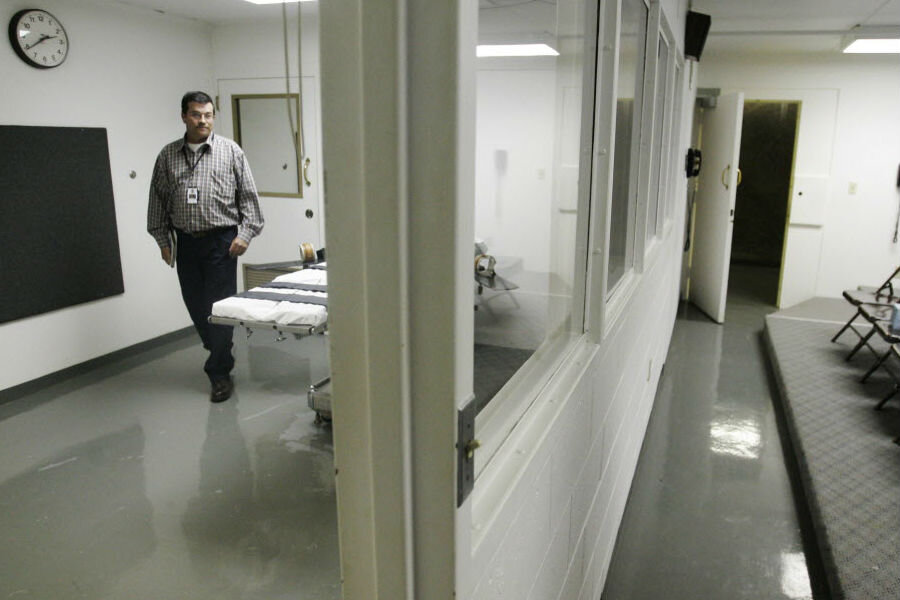Death penalty: Ruling in California finds long delays 'cruel and unusual'
Loading...
A federal judge’s ruling on Wednesday that California’s death penalty is unconstitutional could make it to the US Supreme Court, experts say. Although the decision is unlikely to hold up, they add, it is focusing attention on the decades-long wait facing most death-row inmates.
The decision by US District Judge Cormac Carney found that the state’s application of the death penalty to inmates on death row is so arbitrary and spotty as to be “cruel and unusual" – a reference to the US Constitution's ban on "cruel and unusual punishment."
Judge Carney noted that of the 900 people sentenced to death in the Golden State since 1978, only 13 have been executed. The state has not executed a prisoner since 2006, he noted, and 40 percent of death-row inmates have been imprisoned for more than 20 years.
These delays, recent studies show, stem in part from a byzantine, understaffed appeals process, in which litigation for any given inmate can take dozens of years and cost hundreds of millions of dollars.
“Of course, for an arbitrarily selected few of the 748 inmates currently on Death Row, that remote possibility may well be realized,” Carney wrote in the 29-page ruling. “Yet their selection for execution will not depend on whether their crime was one of passion or premeditation, on whether they killed one person or ten, or on any other proxy for the relative penological value that will be achieved by executing that inmate over any other.”
Experts note that the decision is one of the first to rely on execution delays as a central criterion for striking down the death penalty, but the jury is out on whether Carney’s reasoning is legally solid.
“It seems very odd that the failure to execute inmates is considered cruel,” says Stephanos Bibas, a criminal sentencing expert at the University of Pennsylvania Law School. “If the appellant wants, he certainly could remove the uncertainty and delay hanging over his head.”
Many death penalty experts don’t see Carney’s decision as paradoxical, however. Among them is James Liebman, a professor at Columbia Law School with expertise on the death penalty, who says Californians are so accustomed to the current system that they’ve become blind to its deficiencies.
“There’s no doubt in California that there’s no predictability as to who will be executed and when,” he said. “If this system were enacted today, there’s no doubt it would be considered cruel and unusual."
The state of California is likely to appeal Carney’s decision to the Ninth Circuit Court of Appeals, and the outcome of that appellate decision is up in the air, experts say, as it largely depends on which judges are appointed to consider the case.
Typically, three of the circuit court's 29 judges are randomly selected to hear an appeal, but Carney’s decision would likely merit an en banc review, which, in California, means that 11 judges would hear the case. This is unusual, as most circuit courts hear en banc cases with all judges present, so that judge selection would play no role.
“It’s a real crap shoot, as to whether it will be upheld, but it depends on who hears it,” Mr. Bibas says.
If the death penalty case makes it through the Ninth Circuit, the US Supreme Court will likely hear and overrule Carney’s ruling. But, experts say, the possibility remains that the high court will find the state of California’s justice system to be a specific outlier in need of remedy.
“I think it has a shot in the Ninth Circuit, but I don’t know about the US Supreme Court,” Santa Clara University law professor Gerald Uelman said to the Los Angeles Times. “It is conceivable that the US Supreme Court and the Ninth Circuit could say California is such an outlier – its system is so dysfunctional, with twice the [average] national delay – that it cannot be sustained.”
Anti-death penalty advocates also note that some current justices have implied in the past that exceptionally long wait times may be unconstitutional. That could put additional focus on the wait times of death-row inmates, even were the US Supreme Court to rule against Carney.
“There have been a number of Supreme Court justices already – [former] Justice [John Paul] Stevens and Justice [Stephen] Breyer, in particular – who have identified the problem of delays in individual cases and concluded that there was a problem even at the nonsystemic level,” says Mr. Liebman. “They have appealed to their fellow justices to hear these cases, so far without success.”
In one case in 2011, Justice Breyer was the lone dissenter when the high court called for death-row inmate Manuel Valle to be executed 34 years after murdering a police officer in Coral Gables, Fla. Before that, in 1999, Breyer noted in another lone dissent that 18th-century English law called for executions to take place the day after sentencing.
The average wait time in the US between sentencing and execution as of 2011 was 14 years, 10 months, according to the Department of Justice. As of 2008, this figure was just short of 20 years in California.
That’s a figure that’s growing rapidly, however: Since 2006, when a US district court declared the state's lethal injection methods unconstitutional, California has not executed any of its 748 inmates now on death row.





